- Преподавателю
- Иностранные языки
- Рабочая тетрадь по английскому языку: «Общенациональные праздники и знаменательные даты в Великобритании и США»
Рабочая тетрадь по английскому языку: «Общенациональные праздники и знаменательные даты в Великобритании и США»
| Раздел | Иностранные языки |
| Класс | - |
| Тип | Другие методич. материалы |
| Автор | Куликова Н.Н. |
| Дата | 28.11.2014 |
| Формат | doc |
| Изображения | Есть |
Государственное бюджетное образовательное учреждение
среднего профессионального образования
«Дзержинский педагогический колледж»
Общенациональные праздники и знаменательные даты в Великобритании и США
Рабочая тетрадь по английскому языку
Дзержинск - 2014
Рассмотрена на заседании
предметной комиссии
иностранных языков
протокол № от ___
председатель ПК
Л.Н. Борисова
Составлена в соответствии
с требованиями
Государственного
образовательного стандарта
среднего профессионального образования
Рассмотрена на экспертной
комиссии при НМС
Протокол №____ от _____
Зам. директора по
научно - методической работе
И. В. Тухман
Составитель:
Н. Н. Куликова, преподаватель первой квалификационной категории ГБОУ СПО «ДПК»
Оглавление
Введение
-
Хеллоуин
-
Гай Фокс
-
День Благодарения
-
Рождество
-
Святые Покровители
-
Пасха
Список литературы
ВВЕДЕНИЕ
Рабочая тетрадь «Общенациональные праздники и знаменательные даты в Великобритании и США» адресована студентам 2, 3 курса специальности «Физическая культура», «Дошкольное образование», «Преподавание в начальных классах» изучающим дисциплину «Иностранный язык». Она дает возможность «погрузиться» в интереснейшую историю праздников Соединенных Штатов Америки и Великобритании.
Целью данного учебного пособия является:
-
Развитие речевой компетенции (говорение, письмо, чтение, аудирование).
-
Развитие языковой компетенции - овладение новыми языковыми средствами (фонетическими, орфографическими, лексическими, грамматическими) в соответствии с темами, предложенными в рабочей тетради.
-
Развитие социокультурной компетенции - приобщение студентов к культуре, традициям и реалиям стран английского языка, формирование умений выделять общее и специфическое в культуре родной страны и страны изучаемого языка.
При составлении учебного пособия использовались материалы следующих авторов: Джейн Майлз, Била Боулера и др.
Новизна данного пособия заключается в творческом подходе к разработке структуры пособия. К каждой изучаемой теме прилагаются игровые задания, которые способствуют лучшему восприятию и усвоению нового материала, помогают закрепить и проконтролировать знания, повысить мотивацию к изучению темы.
Данное пособие состоит из одной части, составленной по тематическому принципу. Включает в себя 6 разделов, посвященных темам, изучаемым в течение курса.
Все пособие посвящено общенациональным праздникам и знаменательным датам в Великобритании и США.
Каждая тема содержит краткую лингвострановедческую, страноведческую и социокультурную информацию, а также упражнения для закрепления. Для проверки понимания упражнения могут проводиться как письменно так и устно.
Необходимость в создании учебного пособия вызвана, прежде всего, недостаточной обеспеченностью учебно-методическими материалами дисциплины «Иностранный язык», необходимостью создания рабочей тетради, которая обеспечила бы студентов достаточным языковым материалом с одной стороны, а с другой - помогла развить и воспитать способности и готовности к самостоятельному изучению английского языка и дальнейшему самообразованию с его помощью.
Пособие может быть использовано как дополнительный материал для аудиторной работы, а также для самостоятельной работы студентов.
Unit 1. Halloween.
Task 1. Read the text 'Halloween'.
On October 31, Americans celebrate Halloween. Halloween means 'holy' (hallow) 'evening' (een). This is the evening before the Christian holy day of All Saints Day. On All Saints Day, Christians remember the saints. But Halloween is even older than Christianity. Before Christianity, people in Europe believed that on October 31 ghosts of dead people came back. To scare the ghosts, people dressed like devils and were very noisy. They also made big fires to keep the ghosts away. Later, people did not believe in ghosts, but they kept the day of Halloween for fun.
Immigrants came from Europe to America and brought with them the custom of Halloween. Halloween has some strange symbols. One symbol is the jack -o' - lantern in the window. The jack -o' - lantern is to scare the ghosts. People cut the pumpkin, throw away all of the inside, and cut a face in it. Then they put a candle inside of it.
Today, in the US, Halloween is very popular with children. They wear masks and special costumes. They want to look like skeletons and ghosts. Then they go from house to house and say, 'Trick or treat!' people give them candies, cookies, fruit. When people give nothing, the children sometimes play tricks on them.
Task 2. True or False?
-
All Saints Day is the day before Halloween.
-
Halloween is older than Christianity.
-
Halloween is came from Europe.
-
A jack -o' - lantern is a pumpkin.
-
On Halloween children say 'Trick'.
Task 3. Complete the sentences with the prepositions below.
-
In on into with from
-
Immigrants came -----Europe.
-
Americans celebrate Halloween ------October, 31.
-
You put a jack - o' - lantern ------- the window.
-
A jack - o' - lantern is a pumpkin with a face cut ------it.
-
Halloween is very popular --- children.
-
Children go ------ house to house.
Task 4. Replace the underlined words in the sentences with the words below.
saints ghosts masks scare play tricks skeletons
-
On All Saints Day, Christians remember the holy people.
-
To frighten the ghosts, people dressed like devils.
-
Children wear something to cover their faces.
-
Children want to look like all the bones that make the body.
-
The jack - o' - lantern is to scare the people with no bodies that come back after they die.
-
When people give nothing, the children do something to make them look stupid.
Task5. Halloween word scramble.
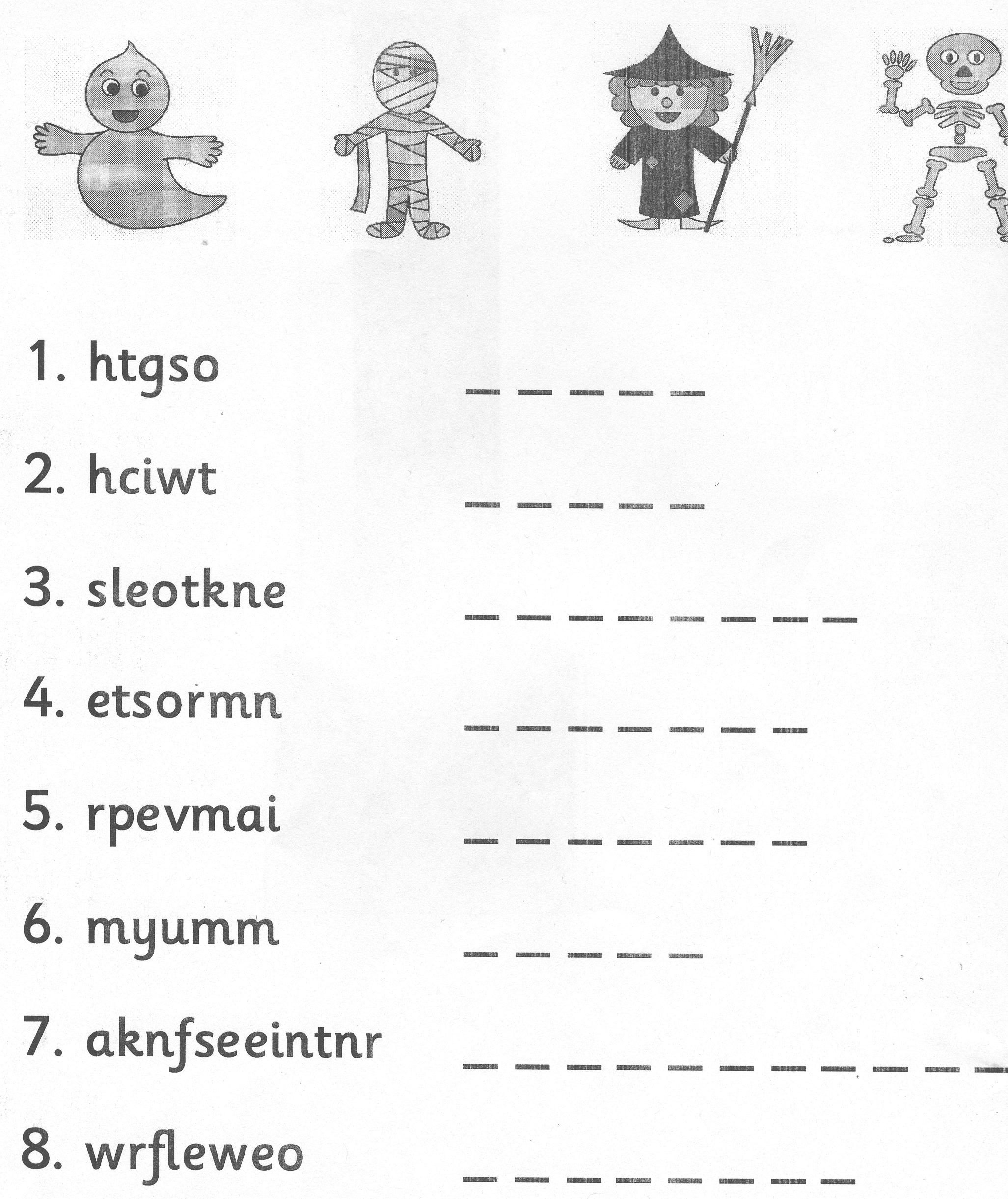
Task 6. Word Search.
Bat boo cat coffin ghost monster moon mummy party treat trick witch
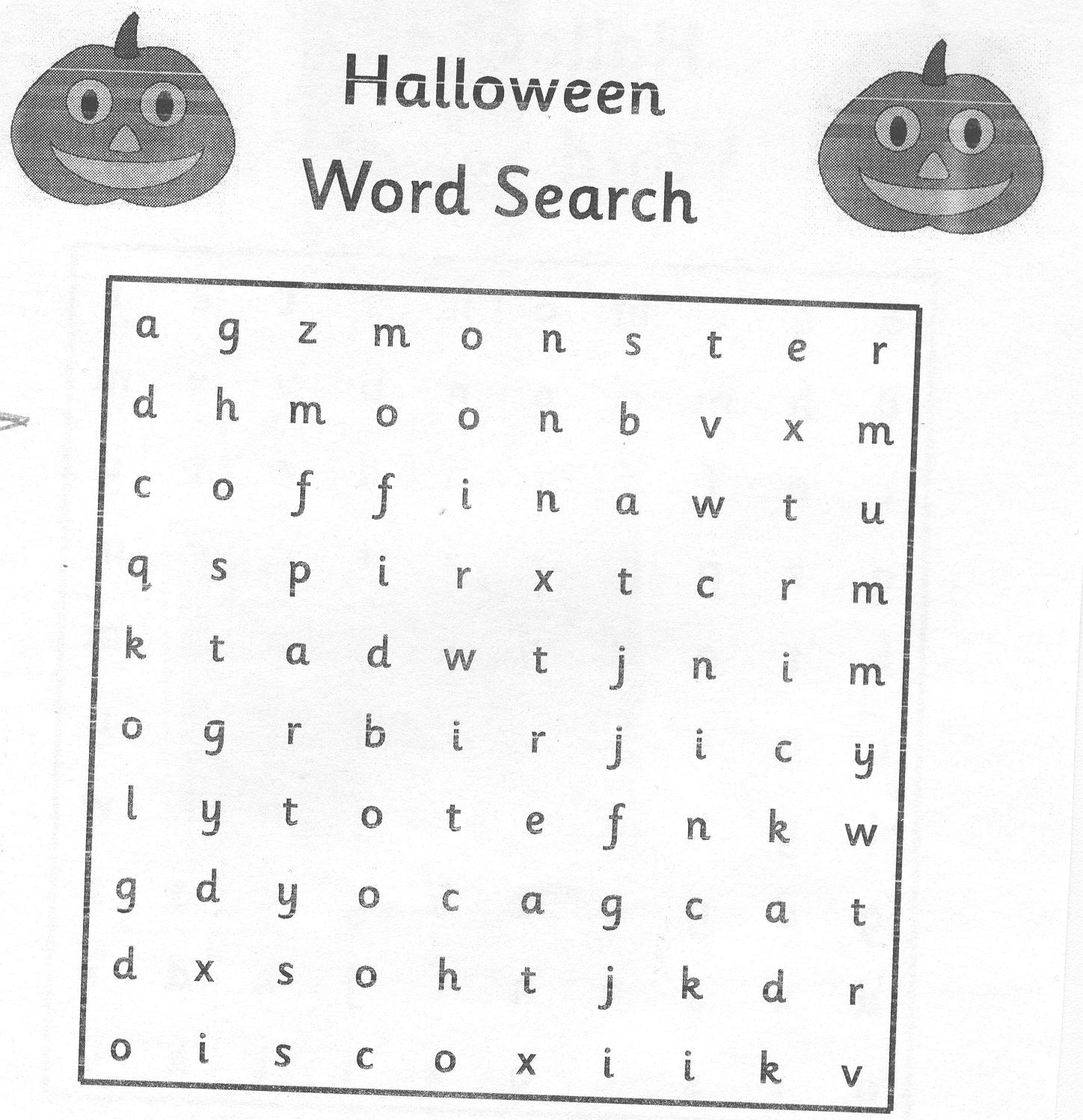
-
Bat boo candy cat coffin ghost haunted monster moon mummy party scream skeleton spooky tomb treat trick witch
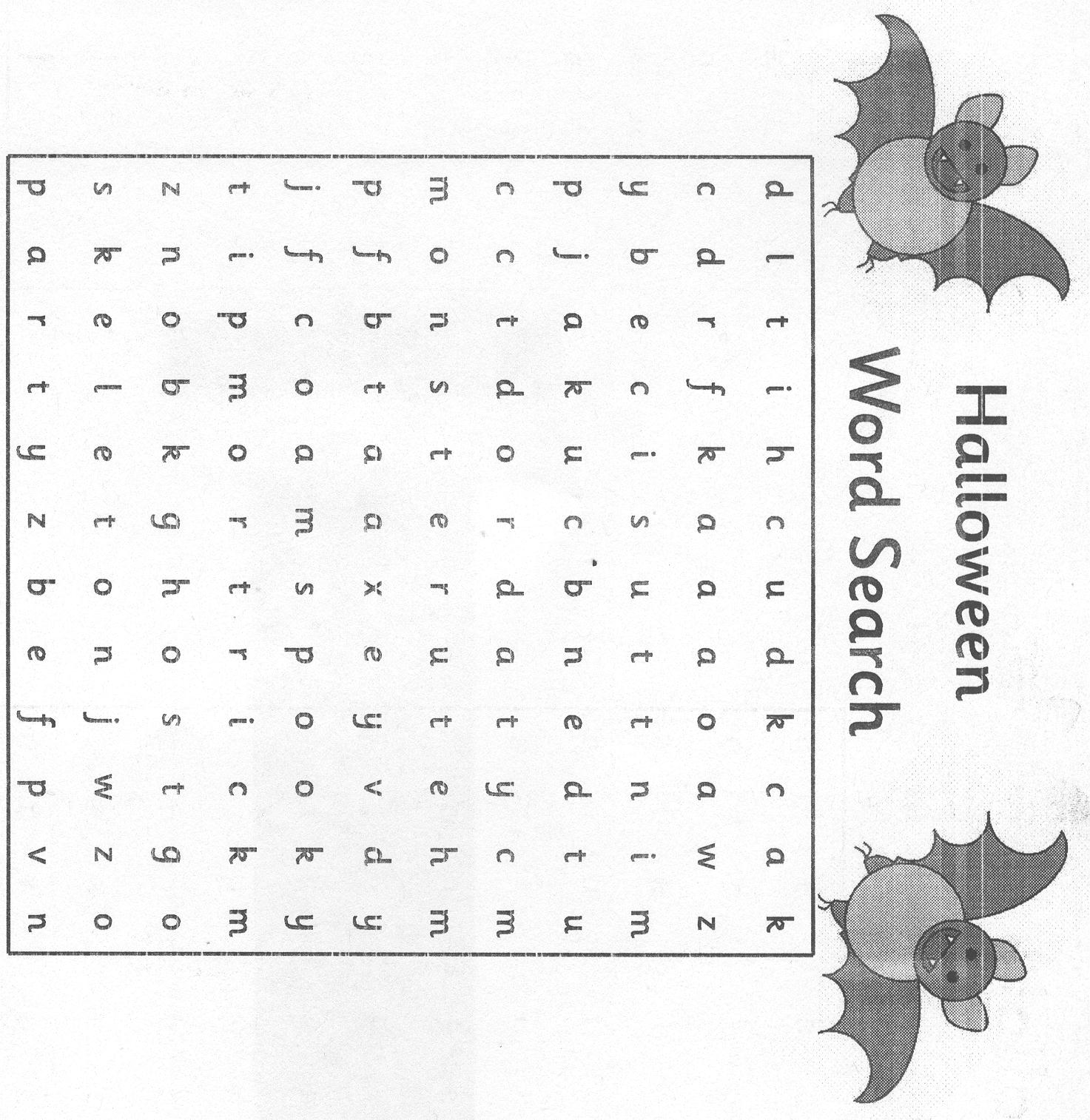
-
Bat boo candy cat cauldron coffin costume Frankenstein ghost graveyard haunted monster moon mummy party scream skeleton spooky tomb treat trick vampire werewolf witch
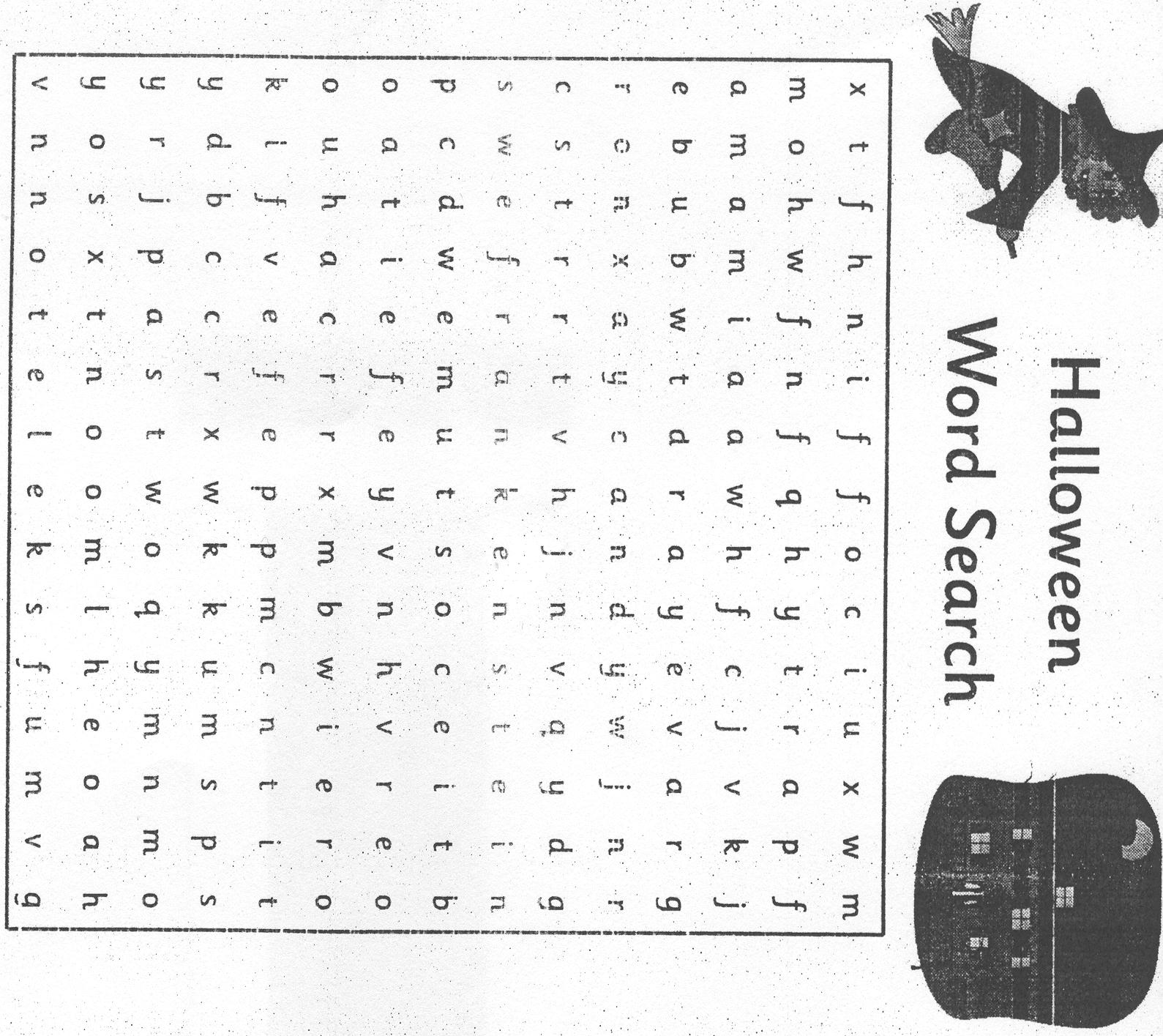
Task 7. Crossword puzzle.

Unit 2. Guy Fawkes and the Gunpowder Plot.
Task 1. Read the text 'Guy Fawkes and the Gunpowder Plot'.
Guy Fawkes was one of the group of men who plotted to blow up the Houses of Parliament in 1605. The Roman Catholic plotters wanted the Protestant King James to be more tolerant to Catholics. One plotter sent a letter to warn a friend not to go to the Houses of Parliament. The King found out and his guards searched the cellars of Parliament and found Guy Fawkes.
Task 2. Complete the sentences using the verbs.
went down
put on
woke up
passed out
carried away
gave up
burst in
knocked over
broke down
brought up
lay down
lay in
got by
got up
called out
called on
fell off
fell over
came round
came across
came up
run away
ran after
sat up
sat down
It was late at night when Guy Fawkes 1… to the cellars of the Houses of Parliament. He looked round for somewhere to sit. At first he 2… on one of the barrels, but then he felt tired so he 3…on the floor. He fell asleep for a few minutes but 4…when he heard a noise. He 5… quickly and hid behind a barrel. A voice 6… 'Who's there?'. Suddenly a group of guards 7… and one of the barrels. They 9… the corner and saw something move. Guy almost 10… as he tried to 11…but they 12… him and caught him. He was13… tortured and executed and a few days later all the other plotters were caught and killed too. Now English people burn a 'guy' on a bonfire each November 5th to remind everyone of that moment in history.
Task 3. Listen to the story and put the pictures in the correct order.
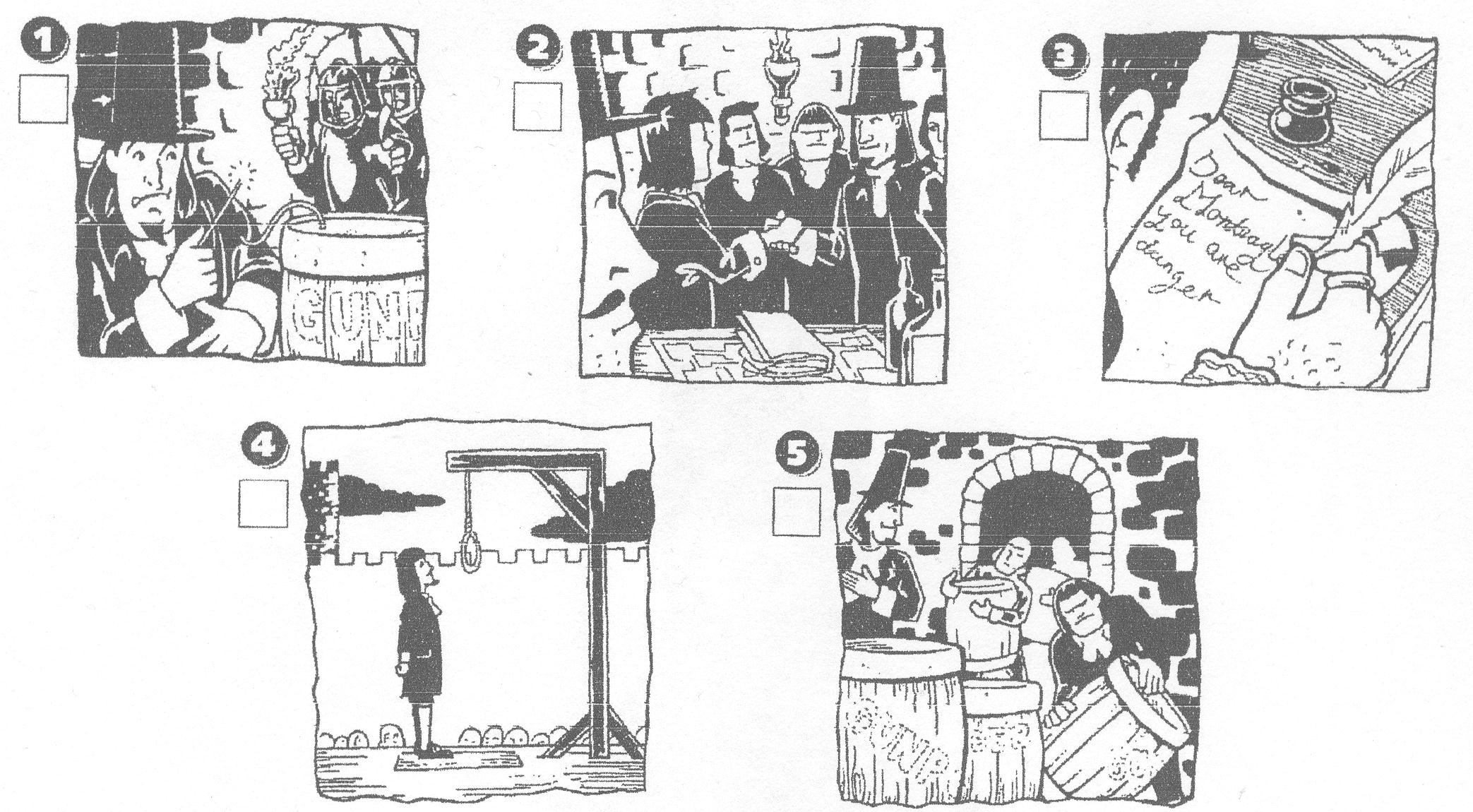
Task 4. Listen again and join these sentences. You need to add a word each time and you might have to remove one.
a) Guy Fawkes was a Catholic. He hated the King.
b) Guy Fawkes joined a group of men. They wanted to kill the king.
c) One of the men had a relative. He often visited the Houses of Parliament.
d) He warned his relative about the plan. His relative warned King James.
e) Guy Fawkes entered the cellar on the night of November 5th. The King's men were already there.
f) They wanted to know the names of the other men. They tortured Guy Fawkes until he confessed.
Task 5. Now join these sentences with the words in the box.
and so when who
a) Guy Fawkes was a Catholic …was born in York.
b) The Catholics were not happy …they decided to blow up Parliament.
c) The King was James 6 of Scotland…James 1 of England.
d) …the King found out about the Gunpowder Plot, he told his men to search the cellars.
e) …the King's men searched the cellars, they found 36 barrels of gunpowder.
f) The leader of the gang was Robert Catesby…was executed with Guy Fawkes.
g) The conspirators were tortured… then they were hanged.
h) The Guy Fawkes failed England stayed as a Protestant country.
Task 6. Match the questions and answers and write the capital letters in the box below. They will tell you the name of the man who stopped the conspiracy.
1. Who was King in 1605?
a. Catholic.
N
2. Why did Guy Fawkes want to kill the King?
b. The King's men killed them.
E
3. What religion was Guy Fawkes?
c. Yes, he did.
L
4. Where did they put the gunpowder?
d. Because he was unfair to Catholics.
O
5. When did they plan to light the gunpowder?
e. On November 5th.
E
6. Who was in the cellar when Guy Fawkes went in?
f. They tortured him.
G
7. What did the King's men do to Guy Fawkes?
g. James.
M
8. Did Guy Fawkes tell the King's men his friends names?
h. The King's men.
A
9. What finally happened to Guy Fawkes and his friends?
i. In a cellar under the Houses of Parliament.
T
The name of the man was: Lord - - - - - - - - -
Task 7. Read the questions about Guy Fawkes. Find the correct answer to each question.
1
Is this a story from the 19th century?
A
Yes, they do.
2
Were Guy Fawkes and his friends Protestants?
Yes, he did.
3
Were there religious problems between the Catholics and the Protestants.
C
Yes, there were
4
Was there a law saying that Catholics weren't allowed to go to church?
D
Yes, they are
5
Did Guy Fawkes and his friends decide to kill King James?
E
Yes, there was
6
Did Guy Fawkes put explosives in the Houses of Parliament?
F
Yes, they did
7
Was the date the 11th of December 1605?
G
No, it isn't. it's a story from the 17th century
8
Did the plan succeed?
H
No, it didn't. The king's soldiers discovered the plan
9
Did the king forgive Guy Fawkes and his friends?
I
No, they weren't. They were Catholics
10
Do British people celebrate Guy Fawkes' Night with bonfires and fireworks?
J
No, he didn't. he decided to kill Guy Fawkes and his friends
11
Do children make models of King James and burn them on the bonfires?
K
No, they aren't. Toffee apples, soup and baked potatoes are popular
12
Are the models called 'guys'?
L
No, it wasn't. it was the 5th of November 1605
13
Are ice - cream and salad popular on Bonfire Night?
M
No, they don't. They make models of Guy Fawkes
Unit 3. The story of Thanksgiving.
Task 1. Put the past simple verbs into the correct spaces.
Invited (W) called (R) had (I) taught (Y) knew(M) sailed(P) were (I) wanted(L) became(S) landed(G) died(M) lived (A) worked(L) had(W) gave(F) lasted (R) grew(O)
In 1620, a group of people 1……….from England to America. There 2……one hundred people on the ship. They 3 ……. to start a new life in America and practice their religion in freedom. They 4…….at a place on the north -east coast of America. They 5……. It Plymouth. They were far from their home, and life was hard. They 6….. little food and they 7…..little about their new home. Their first winter in America was very cold. Many of them 8……. ill and 9……..
However, the Native Americans who 10……….there decided to help them. They 11……the newcomers how to grow corn and other plants to eat, and they 12……..them medicine to treat their illnesses. They also showed their new friends how to hunt for food and how to build better houses. The newcomers 13……..hard and their crops 14……… By November 1621 all of them 15……food and a home. To thank the Native Americans, the newcomers 16……..them to a special dinner to celebrate their friendship. This special dinner was the first Thanksgiving. The first Thanksgiving dinner 17……..for three days.
Now write the letters over the numbers to find out more information about the people in the story.
-
The people who sailed from England to America were called the
-
1
2
3
4
5
6
7
8
-
The ship they sailed on was called the
-
9
10
11
12
13
14
15
16
17
Task 2.
Celebrate dinner family feast harvest November pie pilgrims pumpkin stuffing thankful turkey

Task 3. Word Scramble.
A.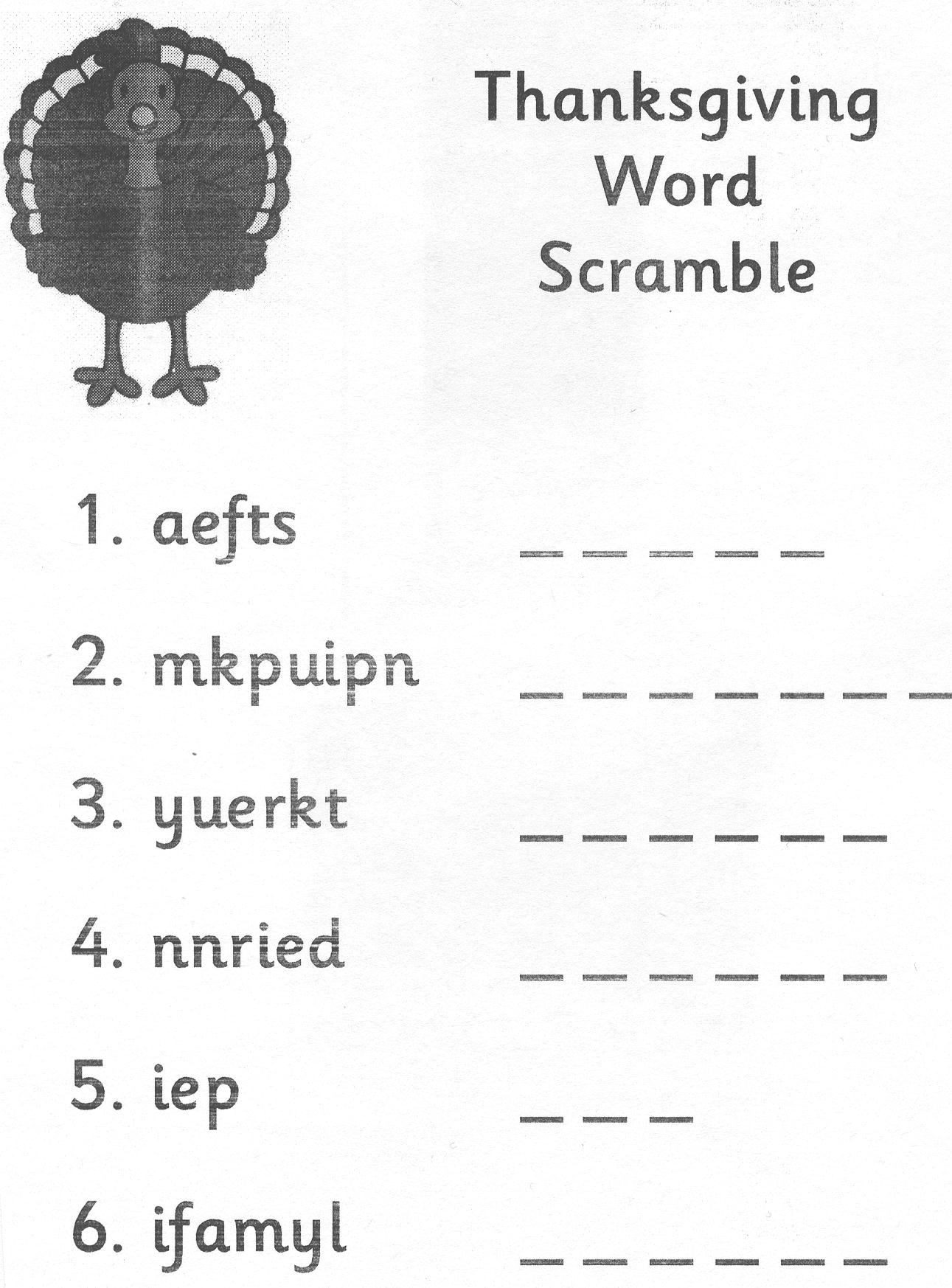
B. 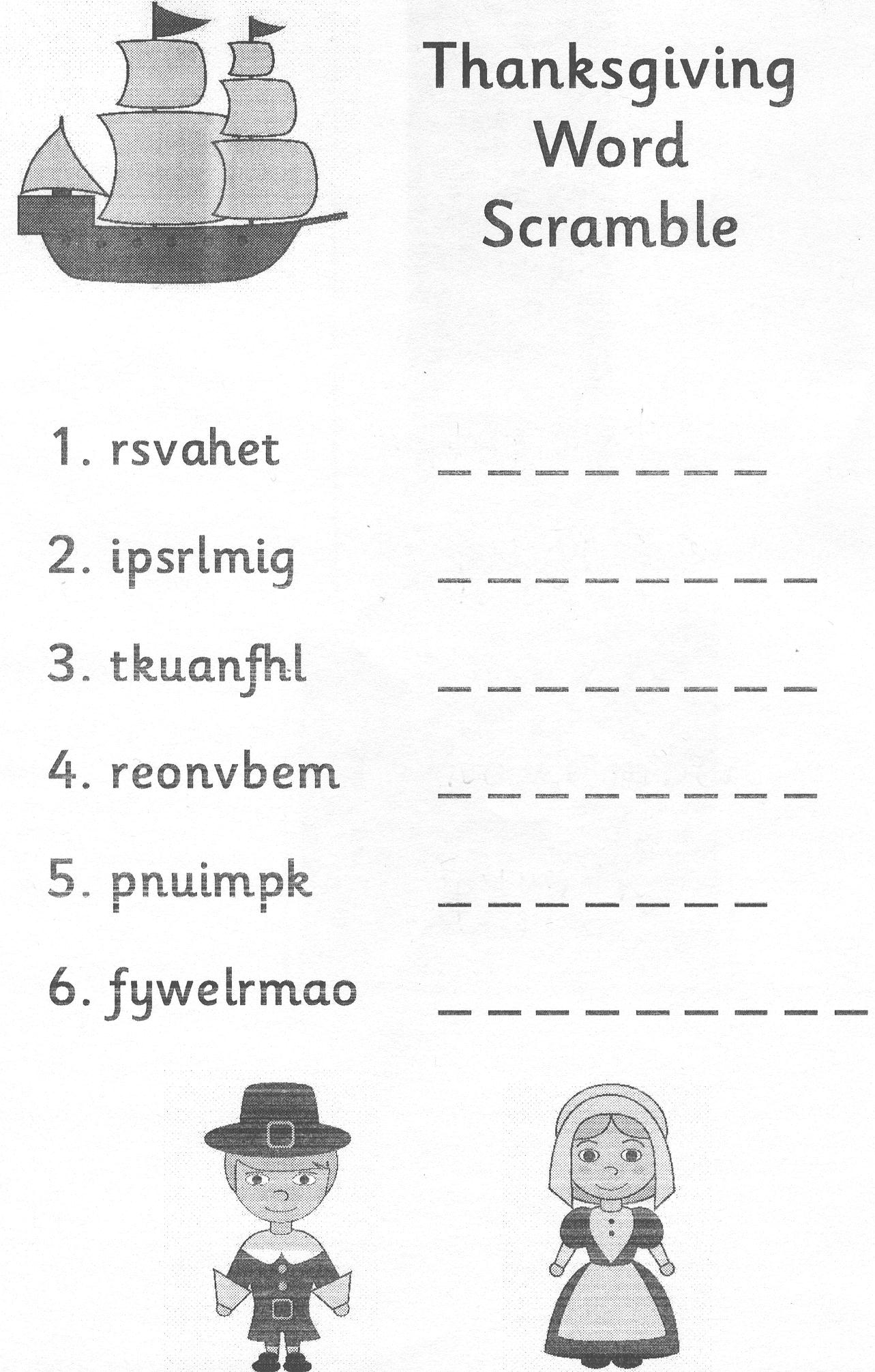
Unit 4. Christmas.
Task 1. Look at the advent calendar. Write the names of the pictures next to the numbers.
Advent calendars are popular in December. You can count the days from the 1st of December to the 25th of December - Christmas Day. Every day you open a door and find a picture.
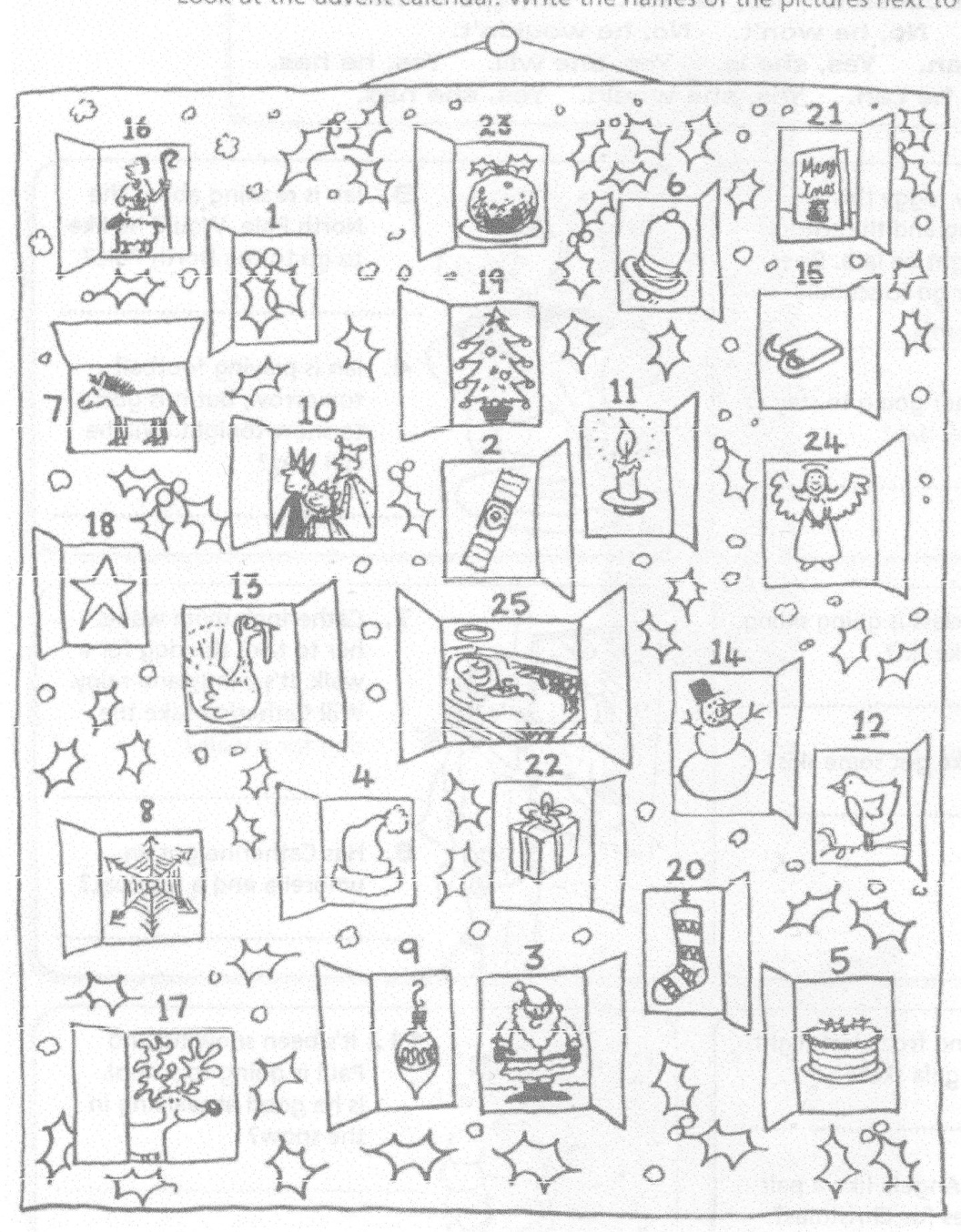
holly
cracker
Father Christmas
hat
Christmas cake
bell
donkey
snowflake
bauble
kings
candle
robin
turkey
snowman
sleigh
shepherd
reindeer
star
Christmas tree
stocking
Christmas card
present
Christmas pudding
angel
baby Jesus
Twenty -one…
Sixteen…
Seven…
Eleven…
Twenty -four…
Three…
Thirteen…
Eight…
Nineteen…
six…
fourteen…
one…
twenty- five…
seventeen…
ten…
twenty -two…
five…
four…
eighteen…
twelve…
nine…
twenty -three…
two…
fifteen…
twenty…
Task 2. Serena is writing to Santa and making a list of all the things she and her family would like to get for Christmas.
Put all the picture words into the plural. To help you, you can find all the words in their singular form in the box.
box candy friend candy mouse pony child ski shoe party tool shelf knife fork dish baby toy scarf cookie friend family house wish
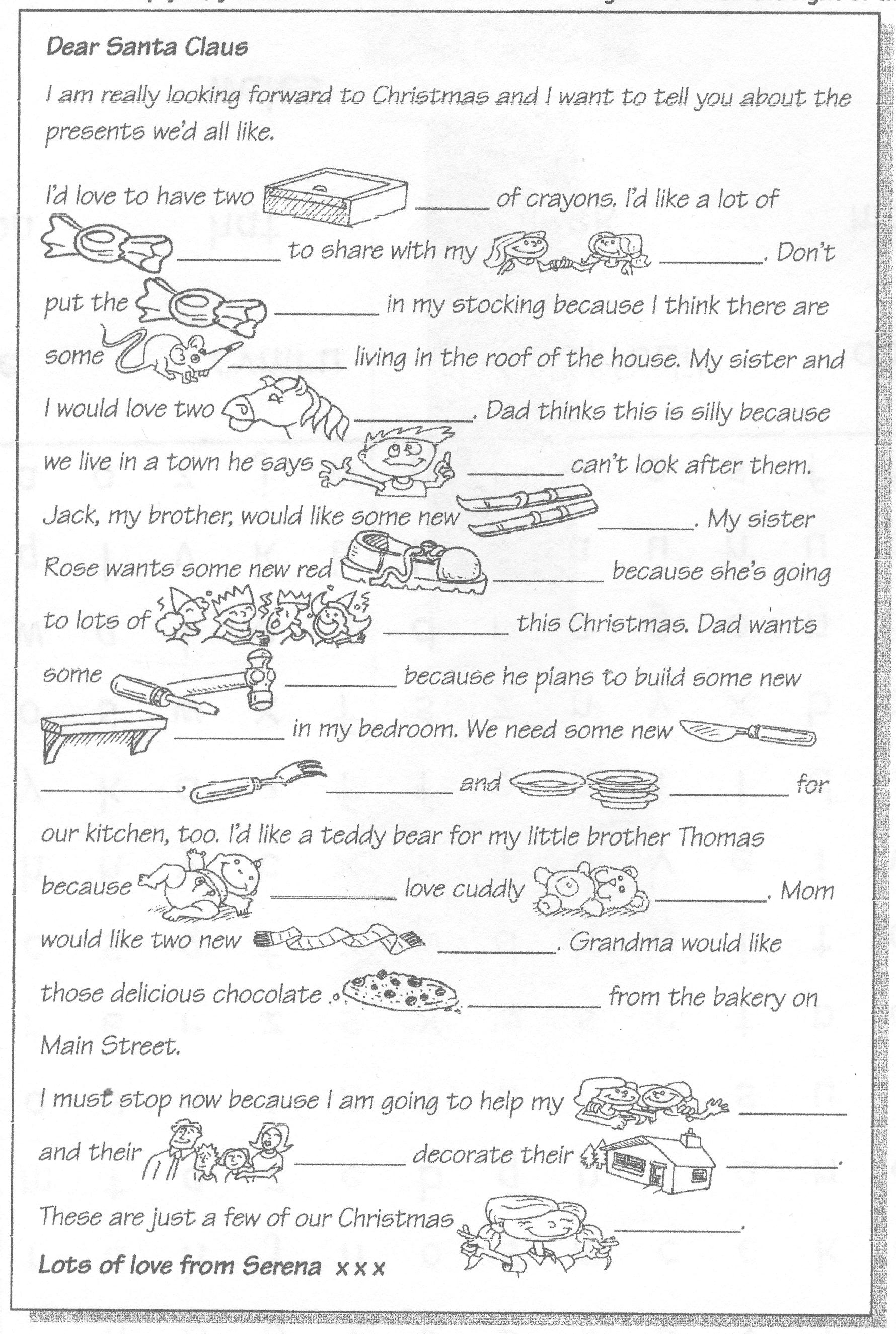
Task 3. Complete the clues and match them to the crossword. Then fill in the crossword with the answers. Decide where each word goes.
Christmas Tree Crossword.
Clues:
A. We eat- - - - - - for lunch on Christmas day.
B. We send - - - - - to our friends at Christmas.
C. We decorate the tree with pretty- - - - - -
D. Christmas is a festival to celebrate the birth of Jesus ----
E. We give each other - - - - - - - - on Christmas day.
F. A - - - - - - - - is a large sock which Santa Claus fills with presents.
G. Christmas is in - - - - - - - -
H. The three kings followed a - - - - to find Jesus.
I. The day before Christmas day is called Christmas - - -
J. Father Christmas is another name for Santa Claus
K. We put an - - - - - on top of the tree.
L. The church - - - - - ring on Christmas day.
13. The day after Christmas day is called - - - - - - day. 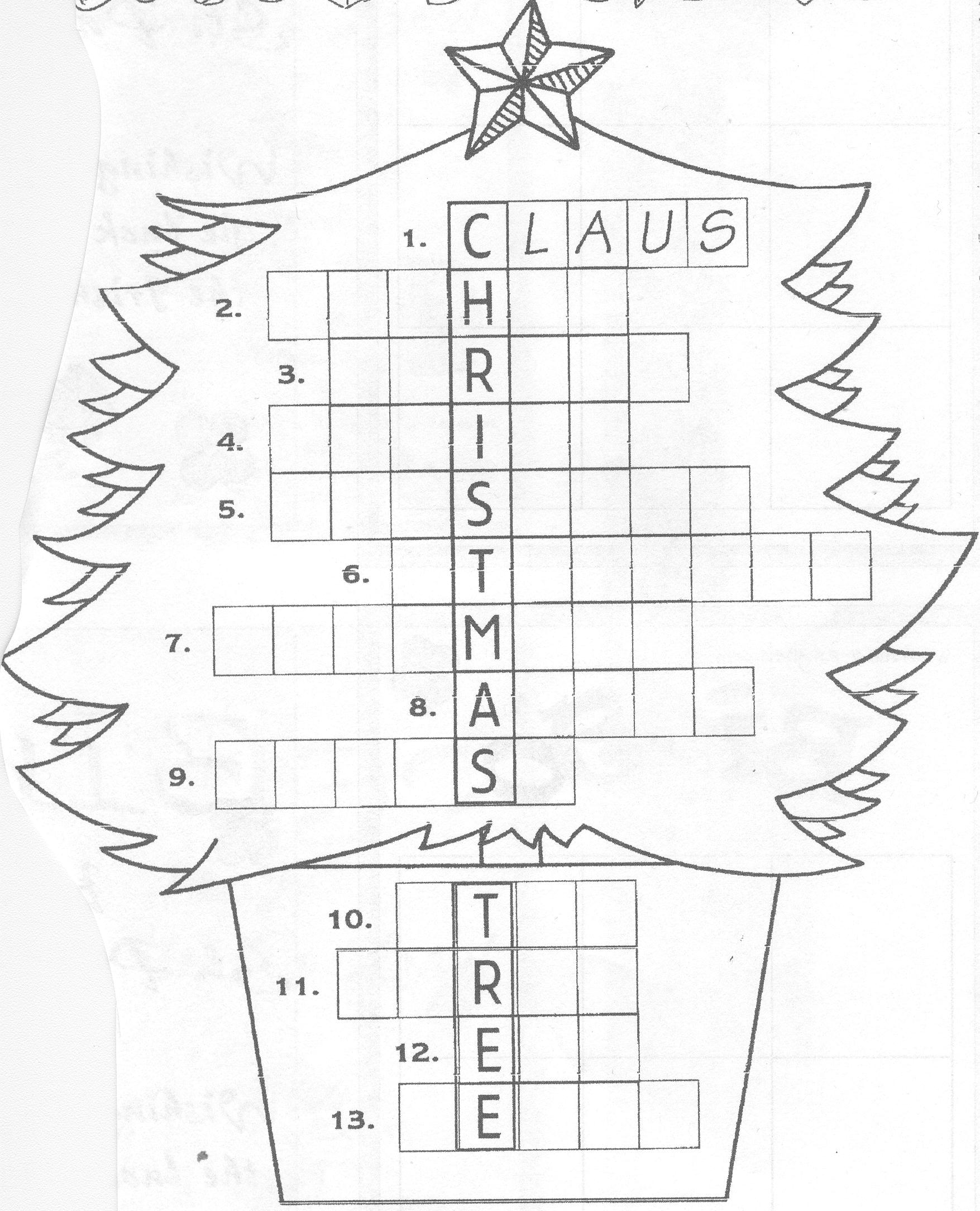
Task 4. Christmas Wordsearch.
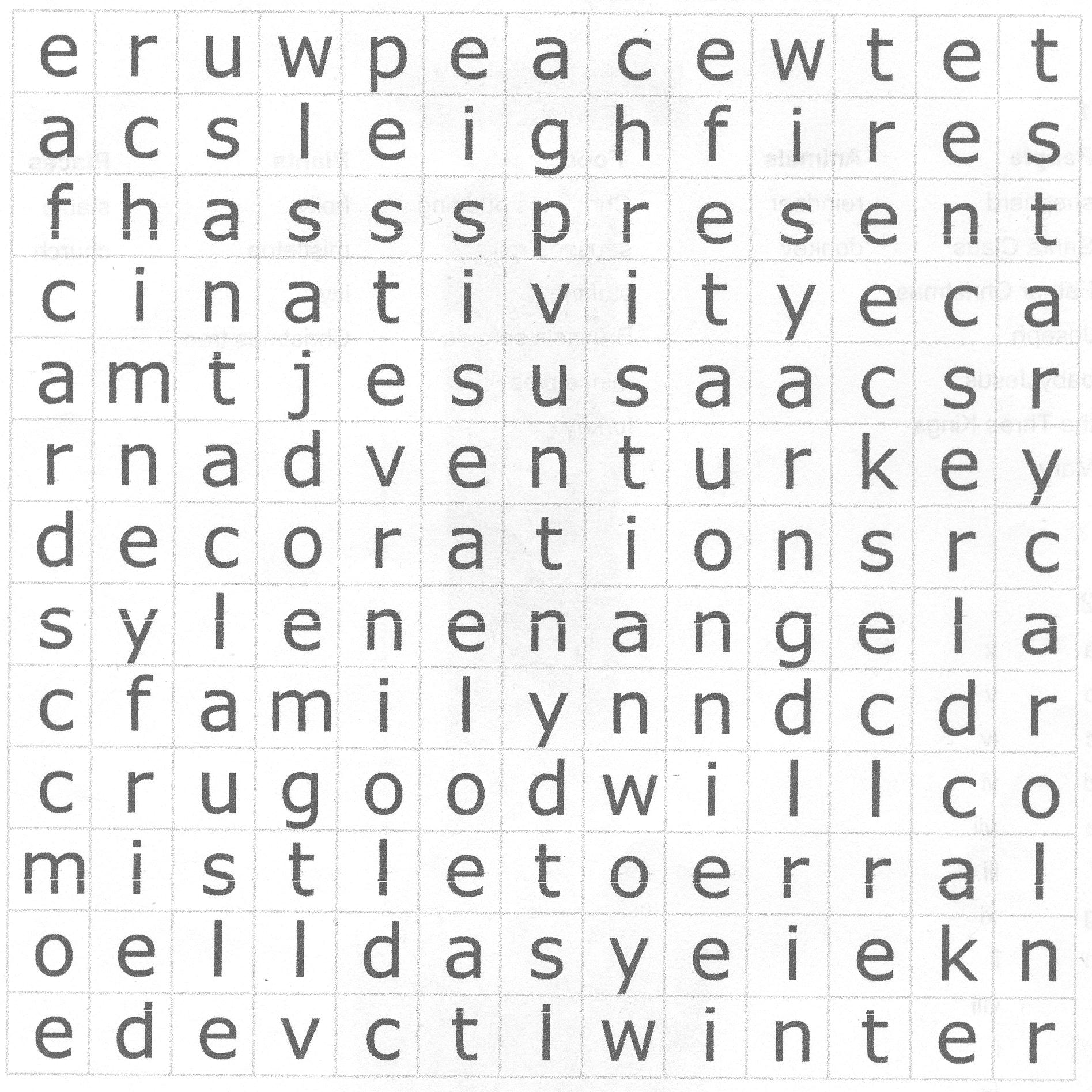
family Jesus angel advent
Santa Claus card cake turkey
peace goodwill winter tree
chimney fire mistletoe nativity
present star decorations sleigh
carol Christian
Task 5. Match a definition to a Christmas word.
a. a traditional Christmas song
b. a kind of sock which gifts are put in
c an object used for travel over snow, pulled by animals
d. metal objects which make a noise when hit
e. traditional Christmas day royal broadcast
f. objects which make a Christmas tree look pretty
g. made of wax and string, it burns slowly
h. a strong wine drunk before a meal
i. a model of a person, made outside in winter
j. gifts
k. a bright light seen in the sky at night
l. the day before Christmas
1. sherry
2.presents
3. candle
4. carol
5.star
6.snowman
7. sleigh
8. decorations
9. The Queen's Speech
10.Christmas Eve
11. bells
12. stocking
Task 6. Which group? Put the words below under the different group headings.
People
Animals
food
plants
Places
Christmas pudding shepherd Santa Claus sausage rolls Father Christmas stable Joseph baby Jesus holly mistletoe the Three Kings reindeer Christmas tree donkey Brussels sprouts stuffing
mince pies Mary turkey church ivy
Task 7. Match the first half of the sentence with the second half to discover more about Christmas traditions.
a Holly and ivy are often used
b We eat the c The Three Kings visited
d We sing Christmas carols e Mary and Joseph had to stay
f Generally we cook our
g We always put our presents
h The children believe in
i People kiss under
j My family
k Santa Claus' sleigh is pulled
1. usually eats mince pies and sausage rolls after
the Queen's speech.
2. Father Christmas.
3. turkey on Christmas morning.
4. baby Jesus in the stable.
5. turkey with stuffing, Brussels sprouts, roast
potatoes and gravy.
6. when we go to church.
7. in a stable, because there were no rooms
free.
8. the mistletoe as a Christmas tradition.
9. by reindeer.
10. as Christmas decorations.
11. around the Christmas tree.
Task 8. Place the words into this short description of John's Christmas in England.
John's Christmas.
Preparations for Christmas start early. We buy the Christmas tree a week or two before and then put the 1………. on it one evening after school. Near to Christmas, we like to light 2…………in the evenings too, because it looks more festive.
The children hang up their 3…….at the end of their beds, on 4……….., and we put some small toys or food into them. On Christmas Day, we usually get woken up quite early by the kids, who are always keen to open their 5……….. We sit around the Christmas tree and open them in the morning.
We like to go to church too. We can hear the 6…….from our house and it's only a short walk. The children like singing 7……
Then, it's back home for a glass of 8……..before Christmas dinner. We eat that and then watch 9……….on TV, like most people in the UK.
If it has snowed, we'll be outside later playing snowballs or making a 10………, and then it's just a relaxing family day watching TV and perhaps playing a few games. We usually eat too much and have to go to bed quite early!
Stockings presents carols the Queen's Speech candles sherry chimney snowman bells decorations
Task 9. Match up the parts of the syllables.
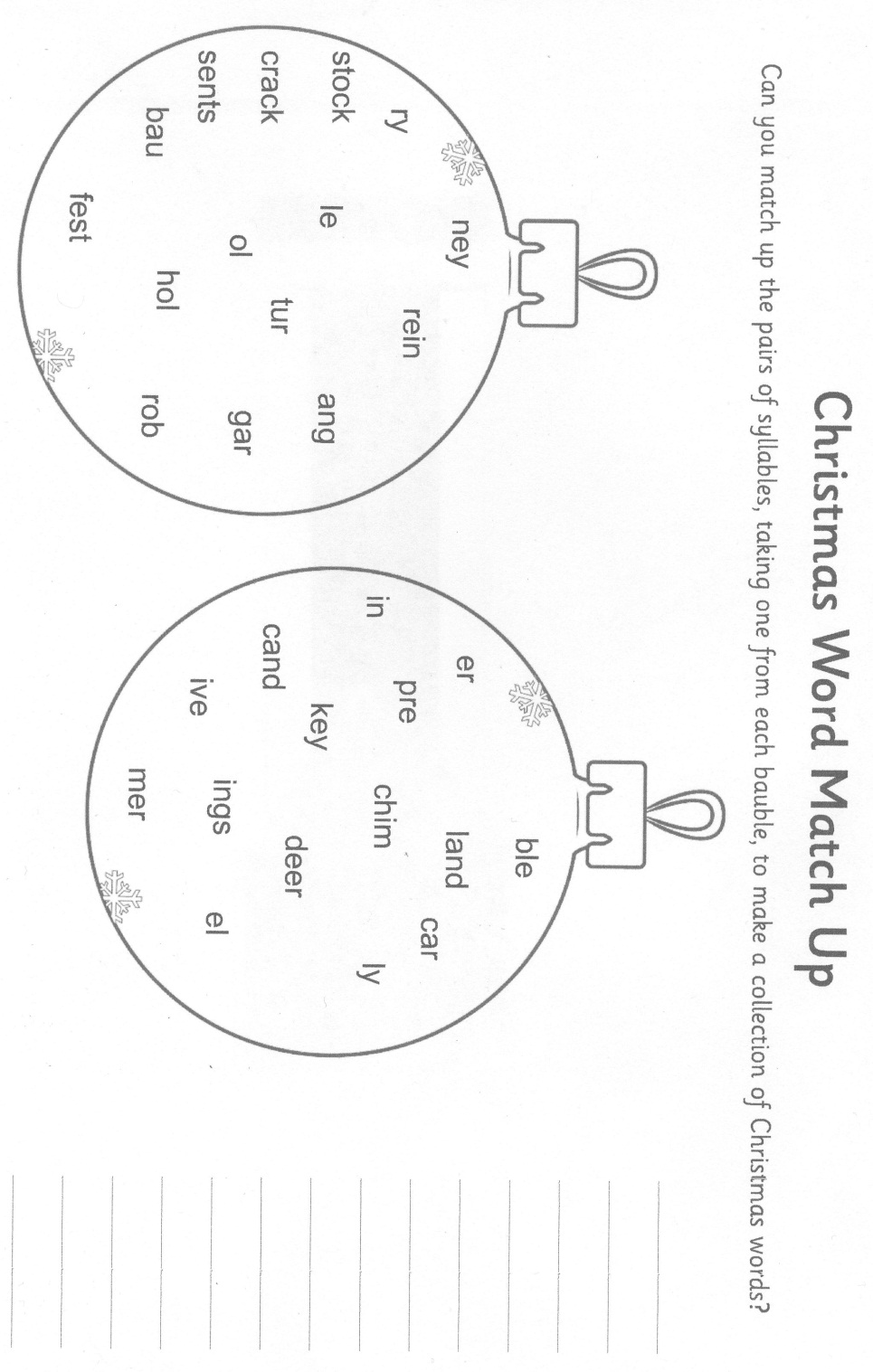
Unit 5. Patron Saints.
Task1. Match the Patron Saint to the Country:
1. David
a. Scotland
2. Andrew
b. England
3. Patrick
c. Wales
4. George
d. Ireland
Task 2. Match the Flag to the Country:
1. Scotland
2. Wales
3. England
4 Ireland
-

 b. c. d.
b. c. d.


Task 3. Read the following story about St Patrick and choose the correct form of the verb (active or passive).
St Patrick was born in Wales. When he was a young man he (took/was taken) prisoner during a war and (was taken/took) to France where he (sold/was sold) as a slave. He (was managed/managed) to escape and he (was become/became) a holy man. He (spent/was spent) all his days praying.
One night Patrick had a dream. He (was told/told) in the dream to go to Ireland to teach Irish people about God. The rest of his life (spent/was spent) in Ireland where he (was built/ built) churches. It (is said/said) that he worked lots of miracles. The Irish say that he got rid of all the snakes in Ireland, and this is why there are no snakes in Ireland today. He prayed for the snakes (to take away/to be taken away) one by one, and they all rushed out of their hiding places and jumped into the sea. But there was one very big old snake that (left behind/was left behind). St Patrick (made/was made) a big wooden box. When the snake (showed/was shown)the box, it said: 'it's too small for me'. 'No', said St Patrick. 'It's perfect for you. Try it and see'. It crawled into the box and curried up into a ball. Immediately Patrick (was closed/closed) the box and threw it into the sea. Now, not a single snake (can find/can be found) in Ireland.
Task 4. Read the sentences and write the correct adjectives in the spaces.
1. St Patrick was born in the 4th century. People think he was Irish but in fact he was…
2. Some people kidnapped him and took him to Ireland when he was very…
3. He had a ….time in Ireland. He had to work as a slave.
4. He escaped and moved to France. He read the Bible and prayed all the time. He was very…
5. St Patrick chose the shamrock as a symbol of his religion. Now the shamrock is the …symbol of Ireland.
6. There are lots of myths and legends about the shamrock. Irish people say that it's very lucky and bad people are …of it.
7. They say that all the…animals ran away when they saw St Patrick with the shamrock in his hand. Maybe this is true because there are no snakes in Ireland!
young dangerous religious Welsh terrible national afraid
Task 5. Tara is on holiday in Ireland. She is writing a postcard to her friend. Read the postcard and find the correct verbs to go in the spaces. Change the verbs to the correct tense and write them in the grid.
to buy to eat to find to be to listen to watch
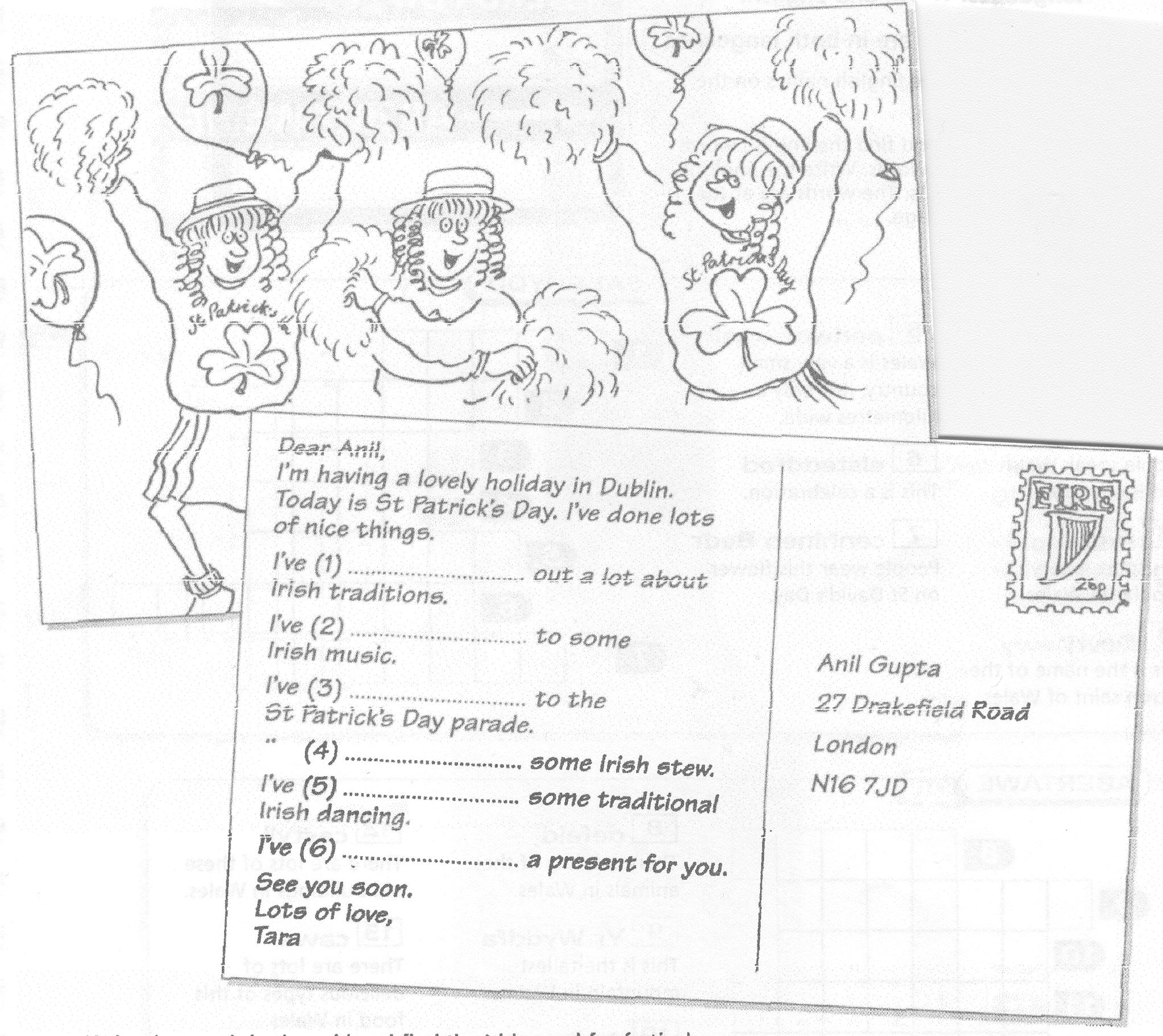
Write the words in the grid and find the Irish word for festival.
Task 6. Word Jumble.
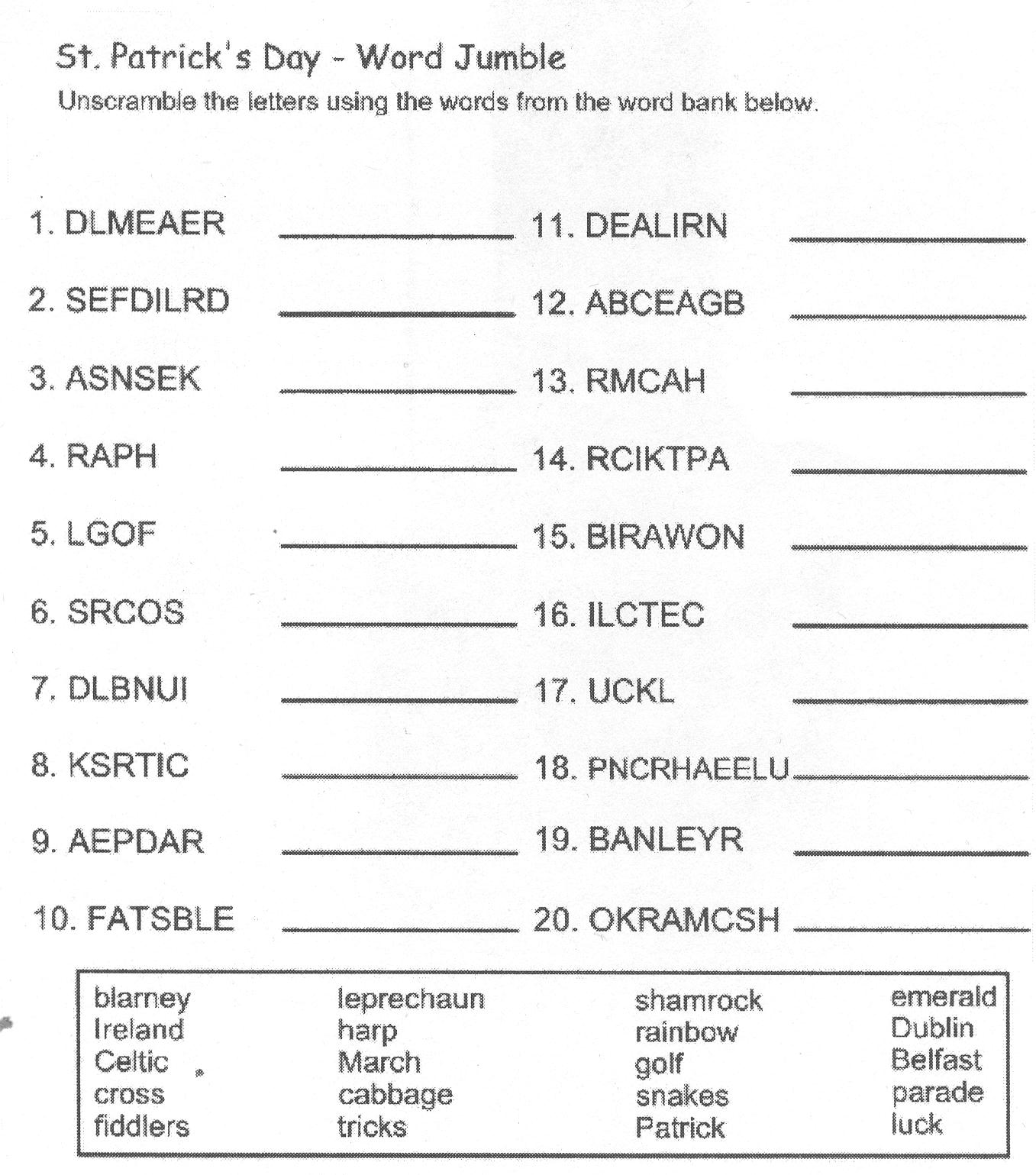
Task 7. Read the text 'Saint Andrew's Day'. Fill in the gaps.
Andrew was one of Christ's Apostles. The _______ tells us he came from the city of Bethsaida. Both Andrew and his brother _______ were__________, but they gave up their jobs so they could follow Jesus.
Why is he remembered? Like the other___________, Andrew lived and worked with___________. Once Jesus was crucified, the disciples became preachers and they spent the rest of their lives working for Christianity.
These were dangerous times for Christians, and Andrew also was _________. Some old stories say that he was ________ to a cross shaped like an X. It's probably not true, but that may be why Saint Andrew (as he became) was given a _______ with an X - shaped cross on it. When the Scots chose him as _______ saint of Scotland, it became their flag.
Andrew is also the patron saint of ________, of Cyprus and of fisherman and sailors. Saint Andrew's cross helps make up part of the Union Flag.
Bible flag fishermen patron Jesus
crucified Peter nailed disciples Russia
Task 8. Read the text 'Who was St George' and fill in the gaps.
The stories say that George was a Knight of Cappadocia around AD 300. One day he visited a town where the people were terrified of a that ate only human beings. The had been chosen as the dragon's next meal, but killed the dragon and saved her from a horrible end. He refused to take any award, but asked the to all become Christians.
Why is he remembered? English heard about St George and so King the Third made him England's special saint. He's also patron saint of the Greek army.
Why should we know about him? St George is the patron saint of and his cross is on the English flag. The cross of St George also makes up part of the 'Jack' Flag which is _____'s flag.
Christian dragon princess George townspeople
knights Edward England Union flag
Although it is not a big event or a national holiday, St George's Day is celebrated on 23rd April each year. It's a great excuse to enjoy or learn about some of England's customs and traditions, and also to think about knights and castles and dragons!
Task 9. Read the text about Saint David.
-
Saint David, or Dewi Sant, as he is known in the Welsh language, is the patron saint of Wales. He was a Celtic monk, abbot and bishop, who lived in the sixth century. During his life, he was the archbishop of Wales, and he was one of many early saints who helped to spread Christianity.
-
Dewi died in the sixth century. He was a very gentle person who lived a poor life. It is claimed that he ate mostly bread and herbs. Despite this poor diet, he was tall and physically strong. Dewi would have probably been a vegetarian, and It is claimed that Dewi lived for over 100 years, and it is generally accepted that he died in 589.
-
Dewi was born in Wales. We know a little about his early life - he was educated in a monastery called Hen Fynyw, he stayed there for many years.
-
Dewi travelled far on his missionary journeys through Wales, where he established several churches. He also travelled to the south and west of England and Cornwall as well as Brittany. It is also possible that he visited Ireland.
-
He founded a monastery where the cathedral city of St. David stands today. The monks were very strict. They worked very hard besides praying. They had to get up very early in the morning for prayers and afterwards work very hard to help maintain life at the monastery. The monks had to keep themselves fed as well as the many pilgrims and travellers who needed lodgings. They also had to feed and clothe the poor and needy in their neighbourhood.
-
There are many stories regarding Dewi's life. It is said that he once rose a boy from death, and milestones during his life were marked by the appearance of springs of water.
-
St. David was, and is, a very important figure to the Welsh. Naturally, then, St. David's Day is a time of great celebration in Wales. Societies all over Wales celebrate with special meetings and events. In St. David's Hall, Cardiff, each March 1st, there will be a concert featuring a 1000-member male voice choir, specially formed for the occasion.
-
St David's Day, as celebrated today, dates back to 1120. His last words to his followers were 'Be joyful, and keep your faith'. Well, we hope that you now have some idea of who St. David was, and why he is so important to us all.
Task 10. David's Wordsearch. Find these words in the wordsearch.
castle cymru daffodil david dragon hat leek march saint wales

Unit 6. Easter.
Task1 . Read the text and find out how people celebrate Easter in the UK.
Easter is an important religious festivity in the UK and traditions are not very different from those in other European countries.
Easter eggs and bunnies, symbolizing the coming of spring and new life, are given as presents at this time of the year. But there are other traditions involving eggs. One of them is "Egg - rolling". People decorate hard boiled eggs with different colours, then take the eggs to the top of a hill and roll them down. The first egg to reach the bottom wins. In Avenham Park, in Lancashire, the annual egg - rolling attracts more than 40,000 people. Nowadays, it's common, though, to use chocolate eggs in this competition instead of real eggs.
Another Easter tradition is "Egg hunting". Parents tell their children that the Easter bunny has brought some Easter eggs and has hidden them in the garden. The children then look for the eggs and the one with the most eggs is the winner.
In the UK, hot cross buns are very popular at Easter. These delicious loaves of bread are made with fruit and spices and they have a cross on the top, symbolizing the 4 quarters of the moon - the hot bun. They are best eaten hot.
Throughout the UK there are also East parades. Adults and children wear special Easter bonnets, decorated with lots of spring flowers.
On Easter Sunday many British go to the Church, which are usually decorated with lots of flowers. Special Easter songs are sung during the religious service. Afterwards, families get together for a special Easter lunch, usually roast lamb with mint sauce and vegetables, followed by the traditional Simnel cake. On Easter Monday people usually stay home and watch some sport on TV, or they go out for the day.
Task 2. Answer these questions on the text.
1. What type of festivity is Easter?
2. Are Easter traditions very different in Europe?
3. Why do people give eggs and bunnies as presents at this time of the year?
4. What kind of eggs are used in the traditional Egg -rolling competition?
5. Who wins the competition?
6. How many people watch the competition at Avenham Park?
7. What do children do during "Egg hunting"?
8. What are hot cross buns made of?
9. What do the British do on Easter Sunday?
Task 3. Find equivalents for these words in the first two paragraphs of the text.
1. significant
2. representing
3. celebration
4. gifts
5. paint
6. held every year
Task 4. Find opposites for these words in the last paragraph of the text.
1. few
2. before that
3. seldom
4. go in
Task 5. Are the sentences true or false? Correct the false ones.
1. Easter is usually celebrated in May.
2. A bunny is a type of a cake.
3. People eat hot cross buns for lunch.
4. The cross is a Christian symbol.
5. Children play games with eggs at Easter.
Task 6. Happy Easter Wordsearch.

Easter eggs bunny basket chocolate parade spring dye hunt decorate tulip lily hide lamb chick
Основная литература
1. Sarah Johnson and Jane Myles: Timesaver London (Elementary- Intermediate), Mary Glasgow Magazines, an Imprint of Scholastic INc., 2004
2. Judith Greet: Timesaver Elementary Listening, Mary Glasgow Magazines, an Imprint of Scholastic INc., 2004
3. Judith Greet: Timesaver Intermediate Listening, Mary Glasgow Magazines, an Imprint of Scholastic INc., 2004
4. Martin Ford and David King: Timesaver for real English in everyday situations, Mary Glasgow Magazines, an Imprint of Scholastic INc., 2004
5. Luke Prodromou: Grammar and Vocabulary for First Certificate with keys, Pearson Education Limited, 2005
6. Sarah Johnson and Jane Myles: Timesaver Read and React, Mary Glasgow Magazines, an Imprint of Scholastic INc., 2004
7. Gwen Berwick and Sydney Thorne: Timesaver Writing Activities, Mary Glasgow Magazines, an Imprint of Scholastic INc., 2004
8. Michael McCarthey and Felicity O'Dell: English Vocabulary in Use (elementary), Cambridge University Press, 1999
9. Stuart Redman: English Vocabulary in Use (pre - intermediate and intermediate), Cambridge University Press, 1997
10. Michael McCarthey and Felicity O'Dell: English Vocabulary in Use (upper - intermediate and advanced), Cambridge University Press, 1994
11. Stuart Redman and Ruth Gairns: Test your English Vocabulary in Use (pre - intermediate and intermediate), Cambridge University Press, 1994
12. Michael McCarthey and Felicity O'Dell: Test your English Vocabulary in Use (upper - intermediate), Cambridge University Press, 2002
13. C. L. Moore, F. Kavanagh and C. Morris: Team Up in English Level 3, ELI s.r.l., 2010
14. Elizabeth Sharman: Across cultures (Longman 2005)
15. James O'Driscoll: Britain (Oxford University Press 2000)
16. Susan Sheerin, Jonathan Seath, Gillian White: Spotlight on Britain (Oxford University Press 2008)
17. Bill Bowler and Lesley Thompson: British History Highlights (pre -intermediate -upper - intermediate), an Imprint of Scholastic INc., 2004
18. Jane Myles: Holidays and special days in the USA, an Imprint of Scholastic INc., 2004
19. School English. - 2005. - №11 page 12-13
20. School English. - 2005. - №12 page 6 - 7
21. School English. - 2006. - № 12 page 27
22. School English. - 2006. - №3 page 24
23. Youngster. -2009. -№ 5 page 14-15
44


